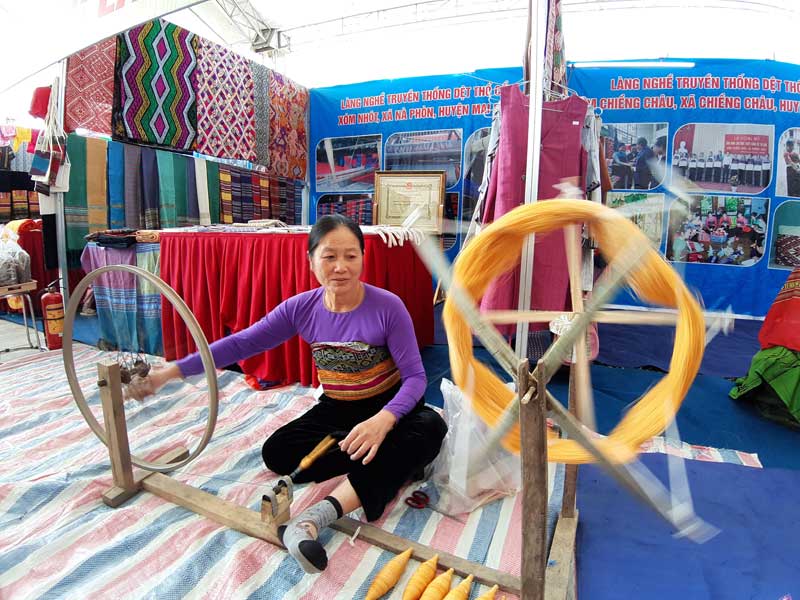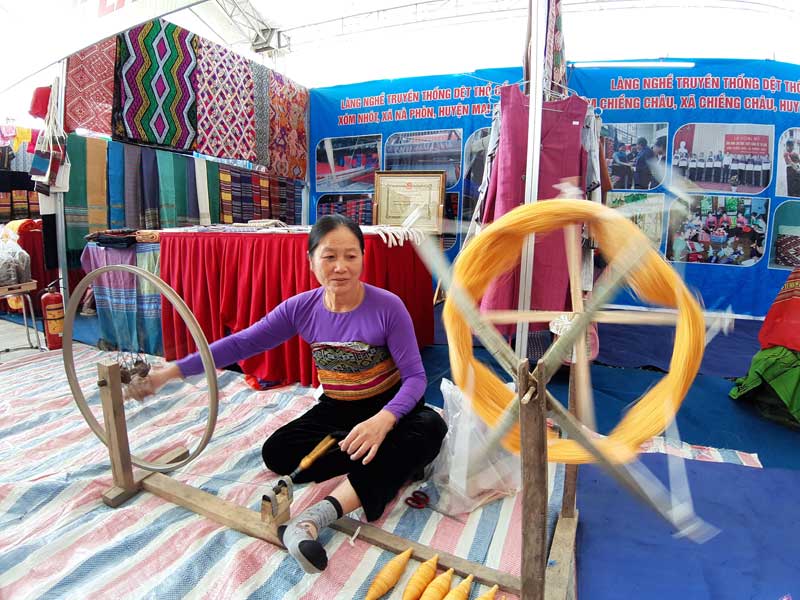
(HBO) - For a long time, the beautiful nature and unique cultural identity of Mai Chau district in northern Hoa Binh province have been named on the national tourist map.
 Mai Chau
preserves the traditional brocade weaving of the Thai ethnic group,
contributing to the locality’s tourism development.
Mai Chau
preserves the traditional brocade weaving of the Thai ethnic group,
contributing to the locality’s tourism development.
The US-basedBusiness Insider magazine listed it as an indigenous
culture worth exploring, and one of the ten tourist destinations that give visitors interesting experiences.
The natural beauty and the Thai ethnic people’s culture fascinate visitors and holds their footsteps.
From the top of Thung Khe pass, tourists can enjoy the dreamy beauty of Vang village
with Thai people’s stilt houses, and green
fields lined up like chessboards hidden in white mists. Mai Chauis sobeautifulallyearround.
Mai Chau
district’s authorities have taken a series of measures to fully tap potential
for tourism development.
The locality has focused on building tourism development plans, preserving
cultural values and traditional handicrafts such as brocade weaving.
Attention has been paid to attracting investment for diversifying tourism
products to meet the demand of visitors.
The district is now home to 15 tourism and trade projects with total registered
capital of over 1.17 trillion VND. A number of them are operating effectively, including
eco-tourism and resort Ecolodge, Mat Troi eco-tourism site, and Mai Chau Hideaway, helping to attracting
more and more holiday-makers to the locality.
The average
number of visitors to Mai Chau increases 3.23 percent a year while the flow of
international arrivals rises 21.94 percent per year. The locality’s annual average
tourism revenue is estimated at 103 billion VND.
In its tourism development strategy, Mai Chau has set to become an attractive,
friendly and safe tourist destination by 2025, striving to realise its goal of tourist
arrivals averagely increasing by 9.7, and revenue from tourism activities
rising by 11.5 percent per year.
The district has just been recognised as a provincial-level tourism area./.
Located just a 20-minute drive from Hoa Binh City, Ora Hill Farmstay & Glamping Hoa Binh is a captivating new destination nestled in Mo hamlet, Bình Thanh commune, Cao Phong district. Combining farming with leisure, this tranquil retreat is perfect for those seeking balance, joy, and an immersive experience in the expansive beauty of nature.
Muong Bi - Tan Lac is renowned as one of the four famous Muong regions in Hoa Binh province. Blessed by nature with a favourable climate and stunning landscapes, Tan Lac holds great advantages for tourism development. The local tourism industry has made remarkable strides in recent times thanks to the attention and support from the local authorities and sectors.
With its strategic location, well-developed transport network, and diverse soil and climatic conditions, Hoa Binh is emerging as a must-visit destination in Vietnam's northwestern tourism corridor. The province boasts numerous attractions, including the Kim Boi hot springs (Kim Boi district), the Dau Rong cave complex (Cao Phong), the Mai Chau valley (Mai Chau), and the iconic Hoa Binh hydropower plant.
The northern mountainous province of Hoa Binh has been listed among the 71 most beautiful places to visit worldwide by the prestigious US travel magazine Condé Nast Traveller.
Hoa Binh province’s rich natural and cultural resources position it as a prime location for developing community-based tourism (CBT). In recent years, support from central and provincial policies, as well as assistance from non-governmental organisations, have encouraged local ethnic minority and mountainous communities to actively engage in the sector.



 Mai Chau
preserves the traditional brocade weaving of the Thai ethnic group,
contributing to the locality’s tourism development.
Mai Chau
preserves the traditional brocade weaving of the Thai ethnic group,
contributing to the locality’s tourism development.